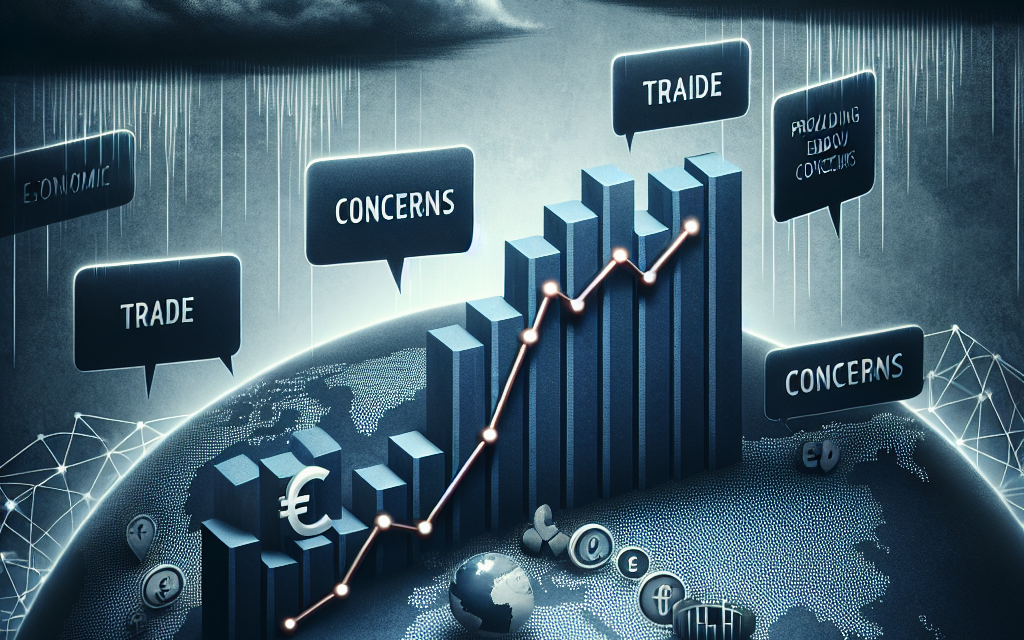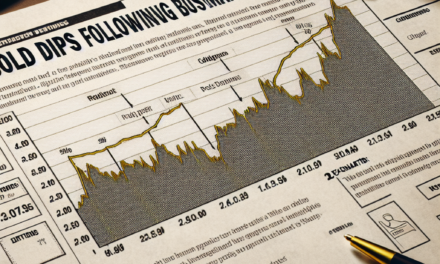“Euro Zone Economy Ends 2024 on a Somber Note: Navigating Trade Turbulence Ahead.”
Introduction
The Euro Zone economy concludes 2024 on a somber note, grappling with persistent trade concerns that have overshadowed growth prospects. Despite initial optimism at the year’s outset, a combination of geopolitical tensions, supply chain disruptions, and inflationary pressures has stifled economic momentum. Key sectors, including manufacturing and exports, have faced significant headwinds, leading to a cautious outlook among businesses and consumers alike. As policymakers navigate these challenges, the focus shifts to implementing strategies aimed at stabilizing the economy and fostering resilience in the face of ongoing uncertainties.
Euro Zone Economic Outlook for 2024
As the Euro Zone approaches the conclusion of 2024, the economic landscape presents a complex and somber picture, shaped by a myriad of factors that have contributed to a cautious outlook. The persistent trade concerns, exacerbated by geopolitical tensions and shifting global supply chains, have cast a shadow over the region’s economic performance. In this context, the Euro Zone’s growth trajectory has been hindered, prompting analysts to reassess their forecasts for the coming year.
One of the primary challenges facing the Euro Zone economy is the ongoing uncertainty surrounding international trade agreements. The ramifications of trade disputes, particularly between major economies, have reverberated throughout the region, affecting both exports and imports. As businesses grapple with fluctuating tariffs and regulatory barriers, many have adopted a more conservative approach to investment and expansion. This hesitance has led to a slowdown in economic activity, which is particularly evident in manufacturing sectors that rely heavily on global supply chains. Consequently, the Euro Zone’s industrial output has experienced a decline, further complicating the economic outlook.
Moreover, inflationary pressures have continued to plague the Euro Zone, driven by rising energy costs and supply chain disruptions. While central banks have implemented measures to stabilize prices, the effectiveness of these interventions remains uncertain. As consumers face higher costs of living, their purchasing power has diminished, leading to a decrease in consumer confidence. This decline in sentiment has had a direct impact on retail sales, which have struggled to maintain momentum in the face of rising prices. As a result, the overall economic growth rate for the Euro Zone has been revised downward, reflecting the challenges that lie ahead.
In addition to these domestic issues, external factors have also played a significant role in shaping the Euro Zone’s economic outlook. The global economic environment remains volatile, with potential slowdowns in key markets posing risks to the region’s export-driven economy. As major trading partners grapple with their own economic challenges, the demand for Euro Zone goods and services has waned, further straining the region’s growth prospects. This interconnectedness underscores the importance of international cooperation and the need for robust trade policies that can mitigate the adverse effects of global uncertainties.
Furthermore, the labor market has shown signs of strain, with unemployment rates remaining stubbornly high in certain member states. While some countries have made strides in reducing joblessness, others continue to face significant challenges in creating sustainable employment opportunities. This disparity not only affects individual livelihoods but also hampers overall economic growth, as a lack of job security can lead to reduced consumer spending and investment.
In light of these multifaceted challenges, policymakers within the Euro Zone are tasked with navigating a precarious economic landscape. The need for coordinated fiscal and monetary policies has never been more pressing, as member states seek to bolster economic resilience and foster growth. As 2024 draws to a close, the Euro Zone’s economic outlook remains clouded by uncertainty, with trade concerns and inflationary pressures continuing to dominate discussions among economists and policymakers alike. The path forward will require careful consideration of both domestic and international factors, as the region strives to regain its footing in an increasingly complex global economy.
Impact of Trade Tensions on Euro Zone Growth
As the Euro Zone economy concludes 2024, it does so under the weight of significant trade tensions that have cast a shadow over its growth prospects. The intricate web of global trade relationships has been strained by a series of disputes, leading to uncertainty that has permeated various sectors within the Euro Zone. This uncertainty has not only affected businesses but has also influenced consumer confidence, which is a critical driver of economic activity. As trade tensions escalate, the repercussions are felt across the entire economic landscape, highlighting the interconnectedness of global markets.
One of the most immediate impacts of these trade tensions has been the disruption of supply chains. Many industries within the Euro Zone rely heavily on imports for raw materials and components. As tariffs and trade barriers have been introduced, companies have faced increased costs and delays, which in turn have hampered production capabilities. This disruption has led to a slowdown in manufacturing output, a key component of the Euro Zone economy. Consequently, the manufacturing sector has reported declining orders, which raises concerns about future investment and employment levels.
Moreover, the uncertainty surrounding trade policies has led to a cautious approach among businesses. Companies are hesitant to make long-term investments or expand operations when the future of trade agreements remains unclear. This reluctance to invest stifles innovation and growth, creating a ripple effect that can dampen overall economic performance. As businesses scale back their expansion plans, the potential for job creation diminishes, further exacerbating the economic challenges faced by the Euro Zone.
In addition to manufacturing, the services sector has also felt the impact of trade tensions. Many service-oriented businesses, particularly those involved in international trade, have reported a decline in demand. As consumers become more cautious in their spending habits due to economic uncertainty, the service sector, which relies heavily on consumer confidence, has experienced a slowdown. This decline in demand not only affects revenue for service providers but also has broader implications for economic growth, as the services sector constitutes a significant portion of the Euro Zone’s GDP.
Furthermore, the trade tensions have led to a deterioration in relations between key trading partners, which has further complicated the economic landscape. The imposition of tariffs and retaliatory measures has created an environment of mistrust, making it increasingly difficult for businesses to navigate international markets. This environment not only affects trade flows but also discourages foreign direct investment, which is vital for fostering economic growth and innovation within the Euro Zone.
As the Euro Zone grapples with these challenges, policymakers are faced with the daunting task of mitigating the adverse effects of trade tensions. The need for a cohesive strategy that addresses both immediate concerns and long-term growth prospects has never been more critical. Efforts to strengthen intra-Euro Zone trade relationships and diversify supply chains may provide some relief, but the overarching issue of global trade tensions remains a significant hurdle.
In conclusion, the impact of trade tensions on Euro Zone growth is profound and multifaceted. As the economy concludes 2024 on a somber note, it is evident that the interplay between trade policies and economic performance will continue to shape the region’s future. The path forward will require careful navigation of these complexities, as the Euro Zone seeks to restore stability and foster an environment conducive to sustainable growth.
Key Indicators of Euro Zone Economic Health
As the Euro Zone economy concludes 2024, a range of key indicators reveals a landscape marked by uncertainty and concern, particularly in light of ongoing trade tensions. The economic performance of the Euro Zone, which comprises 19 of the 27 European Union member states, is often assessed through various metrics, including GDP growth, unemployment rates, inflation, and trade balances. Each of these indicators provides insight into the overall health of the economy and highlights the challenges that lie ahead.
To begin with, GDP growth has been a focal point for economists and policymakers alike. In 2024, the Euro Zone experienced sluggish growth, with many member states struggling to maintain momentum. The average GDP growth rate hovered around 1.2%, a stark contrast to the more robust figures seen in previous years. This deceleration can be attributed to several factors, including rising energy prices, supply chain disruptions, and the lingering effects of the COVID-19 pandemic. As businesses grapple with these challenges, consumer confidence has also taken a hit, further dampening economic activity.
In addition to GDP growth, the unemployment rate serves as a critical indicator of economic health. Throughout 2024, the Euro Zone’s unemployment rate remained relatively stable, fluctuating between 6.5% and 7%. However, this stability masks significant disparities among member states. Countries such as Spain and Italy continue to face higher unemployment rates, particularly among youth, while nations like Germany and the Netherlands enjoy lower rates. This divergence underscores the uneven recovery across the region and raises concerns about social cohesion and economic inequality.
Inflation has emerged as another pressing issue for the Euro Zone economy. Throughout 2024, inflation rates surged, driven primarily by escalating energy costs and supply chain bottlenecks. The European Central Bank (ECB) faced mounting pressure to address these inflationary pressures, which reached levels not seen in over a decade. As a result, the ECB implemented a series of interest rate hikes in an attempt to rein in inflation. However, these measures have sparked debates about the potential impact on economic growth, as higher borrowing costs could stifle investment and consumer spending.
Trade balances also play a crucial role in assessing the Euro Zone’s economic health. In 2024, trade tensions, particularly with major partners such as the United States and China, have created an atmosphere of uncertainty. The imposition of tariffs and trade barriers has led to a decline in exports, which are vital for many Euro Zone economies. Consequently, the trade balance has shifted, with several countries reporting deficits that could further exacerbate economic challenges. The interconnectedness of global supply chains means that disruptions in one area can have ripple effects throughout the Euro Zone, complicating recovery efforts.
In conclusion, the key indicators of the Euro Zone’s economic health paint a somber picture as 2024 draws to a close. Sluggish GDP growth, persistent unemployment disparities, rising inflation, and trade concerns collectively contribute to an atmosphere of uncertainty. As policymakers navigate these challenges, the need for coordinated action becomes increasingly apparent. Addressing the underlying issues that hinder economic performance will be essential for fostering a more resilient and sustainable Euro Zone economy in the years to come. The path forward will require not only a careful balancing of monetary policy but also a commitment to enhancing trade relationships and supporting vulnerable sectors within the economy.
The Role of Inflation in Euro Zone Economic Challenges
As the Euro Zone economy concludes 2024, it faces a myriad of challenges, with inflation emerging as a significant factor contributing to its somber state. The persistent rise in prices has not only eroded consumer purchasing power but has also complicated the monetary policy landscape for the European Central Bank (ECB). In this context, understanding the role of inflation is crucial to grasping the broader economic challenges that the Euro Zone is currently navigating.
To begin with, inflation in the Euro Zone has been driven by a combination of factors, including supply chain disruptions, energy price volatility, and increased demand as economies emerged from pandemic-related restrictions. These elements have created a perfect storm, leading to a surge in consumer prices that has outpaced wage growth. Consequently, households are feeling the pinch, as their disposable income diminishes, which in turn affects consumer spending—a vital component of economic growth. As spending declines, businesses face reduced revenues, leading to a slowdown in investment and hiring, further exacerbating the economic malaise.
Moreover, the ECB’s response to rising inflation has been a delicate balancing act. On one hand, the central bank has sought to rein in inflation through interest rate hikes, aiming to stabilize prices and restore confidence in the economy. On the other hand, these rate increases have raised concerns about stifling growth, particularly in an environment where many sectors are still recovering from the pandemic’s impact. This dual mandate of controlling inflation while fostering economic growth has placed the ECB in a challenging position, as it navigates the fine line between tightening monetary policy and supporting a fragile recovery.
In addition to these monetary policy challenges, inflation has also sparked debates about fiscal policy within the Euro Zone. Governments are grappling with the need to provide support to vulnerable populations while simultaneously addressing the rising costs of public services and debt servicing. The pressure to implement targeted fiscal measures has intensified, as policymakers recognize that unchecked inflation could lead to social unrest and further economic instability. Thus, the interplay between inflation and fiscal policy becomes increasingly critical, as governments strive to strike a balance between immediate relief and long-term sustainability.
Furthermore, the impact of inflation extends beyond domestic borders, influencing trade dynamics within the Euro Zone and with its global partners. As inflation rates rise, the competitiveness of Euro Zone exports may be compromised, particularly if trading partners maintain lower inflation rates. This situation could lead to a deterioration of trade balances, further straining the economic outlook. Additionally, the uncertainty surrounding inflation can deter foreign investment, as investors seek more stable environments for their capital. This potential decline in investment could stifle innovation and growth, creating a vicious cycle that is difficult to escape.
In conclusion, the role of inflation in the Euro Zone’s economic challenges cannot be overstated. As the region grapples with the consequences of rising prices, the interplay between monetary policy, fiscal measures, and trade dynamics becomes increasingly complex. The somber economic outlook for 2024 serves as a reminder of the delicate balance that must be maintained to foster stability and growth. Moving forward, addressing inflation will require coordinated efforts from policymakers, as they seek to navigate the turbulent waters of an evolving economic landscape. Only through a comprehensive understanding of these dynamics can the Euro Zone hope to emerge from its current challenges and pave the way for a more resilient future.
Policy Responses to Trade Concerns in the Euro Zone
As the Euro Zone economy concludes 2024 on a somber note, the persistent trade concerns have prompted a series of policy responses aimed at stabilizing the region’s economic landscape. The interconnectedness of global markets means that trade dynamics significantly influence the Euro Zone’s economic health. Consequently, policymakers have been compelled to address these challenges with a multifaceted approach, recognizing that the implications of trade tensions extend beyond mere tariffs and quotas.
In light of the ongoing trade disputes, particularly with major partners such as the United States and China, the European Central Bank (ECB) has taken a proactive stance. By adjusting monetary policy, the ECB aims to mitigate the adverse effects of trade uncertainties on economic growth. Lowering interest rates and implementing quantitative easing measures are among the strategies employed to stimulate investment and consumer spending. These actions are designed to provide a buffer against the potential downturns caused by reduced trade volumes and increased costs associated with tariffs.
Moreover, the European Commission has initiated discussions on enhancing the region’s trade resilience. This involves not only addressing immediate trade barriers but also fostering a more robust internal market. By promoting intra-EU trade, the Commission seeks to reduce dependency on external markets, thereby cushioning the Euro Zone from global trade fluctuations. Initiatives aimed at strengthening supply chains within the region are also being prioritized, as they can enhance competitiveness and reduce vulnerability to external shocks.
In addition to monetary and trade policy adjustments, the Euro Zone has recognized the importance of strategic partnerships. Engaging in dialogue with key trading partners is essential for addressing trade concerns collaboratively. The Euro Zone has been actively pursuing trade agreements that not only open new markets but also establish frameworks for resolving disputes amicably. Such agreements are crucial in creating a more predictable trading environment, which is vital for businesses operating within the Euro Zone.
Furthermore, the Euro Zone’s response to trade concerns has included a focus on innovation and digital transformation. By investing in technology and research, the region aims to enhance its competitive edge in the global market. This approach not only addresses immediate trade challenges but also positions the Euro Zone as a leader in emerging industries. The emphasis on innovation is expected to drive economic growth and create jobs, thereby contributing to overall stability in the face of trade uncertainties.
As the Euro Zone navigates these complex trade dynamics, it is also essential to consider the social implications of policy responses. Policymakers are increasingly aware that trade policies can have significant effects on employment and income distribution. Therefore, measures aimed at supporting affected sectors and workers are being integrated into the broader policy framework. This includes retraining programs and financial assistance for industries that may be adversely impacted by trade disruptions.
In conclusion, the Euro Zone’s policy responses to trade concerns reflect a comprehensive strategy aimed at fostering economic resilience. By combining monetary policy adjustments, strengthening internal markets, pursuing strategic partnerships, and investing in innovation, the region seeks to navigate the challenges posed by global trade dynamics. As the Euro Zone moves forward, the effectiveness of these policies will be crucial in determining the region’s economic trajectory in an increasingly uncertain global landscape.
Sectoral Analysis: Industries Affected by Trade Issues
As the Euro Zone economy concludes 2024, it finds itself grappling with a series of trade concerns that have significantly impacted various sectors. The ramifications of these trade issues are felt across the board, affecting industries that are crucial to the region’s economic stability and growth. In particular, the manufacturing, agriculture, and technology sectors have experienced notable disruptions, each facing unique challenges that stem from the broader trade environment.
To begin with, the manufacturing sector, which has long been a cornerstone of the Euro Zone economy, is facing headwinds due to increased tariffs and trade barriers. These obstacles have not only raised production costs but have also complicated supply chains that rely on cross-border transactions. As a result, many manufacturers are experiencing delays in the delivery of raw materials, which in turn hampers their ability to meet production schedules. This situation has led to a decline in output, with several companies reporting reduced orders and a cautious outlook for the coming months. Furthermore, the uncertainty surrounding trade agreements has prompted some manufacturers to reconsider their investment strategies, leading to a slowdown in capital expenditures that could have otherwise stimulated growth.
In addition to manufacturing, the agricultural sector is also feeling the strain of trade tensions. Farmers and agribusinesses have been particularly vulnerable to fluctuations in trade policies, as many rely heavily on exports to sustain their operations. The imposition of tariffs on agricultural products has made it increasingly difficult for European farmers to compete in global markets, resulting in a surplus of goods that cannot be sold at profitable prices. This oversupply has led to a decline in farm incomes, prompting some producers to scale back their operations or even exit the market altogether. Moreover, the uncertainty surrounding trade negotiations has made it challenging for farmers to plan for the future, further exacerbating the difficulties faced by this vital sector.
Transitioning to the technology industry, it is evident that trade issues have also cast a shadow over this dynamic sector. The technology landscape in the Euro Zone is characterized by rapid innovation and a strong emphasis on research and development. However, trade barriers and restrictions on technology transfers have hindered collaboration between European firms and their international counterparts. This has stifled the flow of ideas and resources that are essential for technological advancement. Additionally, companies in the tech sector are increasingly concerned about the potential for retaliatory measures that could disrupt their operations and limit their access to key markets. As a result, many firms are adopting a more cautious approach to expansion, which could have long-term implications for the region’s competitiveness in the global technology arena.
In conclusion, the Euro Zone economy’s somber conclusion to 2024 is largely attributable to the pervasive trade concerns that have affected multiple sectors. The manufacturing, agriculture, and technology industries are all grappling with the consequences of increased tariffs, supply chain disruptions, and uncertainty surrounding trade agreements. As these sectors navigate the challenges posed by the current trade environment, it is crucial for policymakers to address these issues proactively. By fostering a more stable and predictable trade landscape, the Euro Zone can work towards revitalizing its economy and ensuring that its key industries remain resilient in the face of ongoing challenges. Ultimately, the path forward will require collaboration and strategic planning to mitigate the adverse effects of trade concerns and to lay the groundwork for sustainable economic growth in the years to come.
Future Prospects for Euro Zone Recovery Post-2024
As the Euro Zone concludes 2024 on a somber note, the future prospects for its economic recovery remain a topic of considerable debate among analysts and policymakers. The persistent trade concerns, exacerbated by geopolitical tensions and supply chain disruptions, have cast a shadow over the region’s economic landscape. In light of these challenges, it is essential to explore the potential pathways for recovery and the factors that may influence the Euro Zone’s economic trajectory in the coming years.
One of the primary considerations for the Euro Zone’s recovery is the need for a cohesive and coordinated response to the ongoing trade issues. The region’s reliance on exports has made it particularly vulnerable to fluctuations in global demand and trade policies. As countries around the world grapple with their own economic challenges, the Euro Zone must prioritize strengthening its internal market. By fostering greater intra-regional trade and reducing dependency on external markets, the Euro Zone can enhance its resilience against future shocks. This approach not only promotes economic stability but also encourages innovation and competitiveness within member states.
Moreover, investment in digital and green technologies is crucial for the Euro Zone’s long-term recovery. The transition to a more sustainable economy presents both challenges and opportunities. As the region seeks to meet its climate goals, investments in renewable energy, energy efficiency, and sustainable infrastructure will be vital. These initiatives not only contribute to environmental sustainability but also create jobs and stimulate economic growth. By positioning itself as a leader in the green economy, the Euro Zone can attract investment and drive innovation, ultimately enhancing its global competitiveness.
In addition to technological advancements, addressing labor market challenges will be essential for the Euro Zone’s recovery. The pandemic has highlighted existing disparities in employment and skills across member states. To foster a more inclusive recovery, policymakers must focus on upskilling and reskilling the workforce, ensuring that individuals are equipped to meet the demands of a rapidly changing economy. Furthermore, promoting labor mobility within the Euro Zone can help alleviate regional disparities and enhance overall economic performance. By investing in education and training programs, the region can build a more resilient workforce capable of adapting to future challenges.
Another critical factor influencing the Euro Zone’s recovery is the role of monetary policy. The European Central Bank (ECB) has played a pivotal role in supporting the economy through low interest rates and quantitative easing measures. However, as inflationary pressures mount, the ECB faces the delicate task of balancing economic support with the need to maintain price stability. The decisions made by the ECB in the coming months will significantly impact the Euro Zone’s economic outlook. A cautious approach that considers both growth and inflation will be essential to navigate the complexities of the current economic environment.
In conclusion, while the Euro Zone concludes 2024 on a somber note, the prospects for recovery are not entirely bleak. By focusing on strengthening internal markets, investing in sustainable technologies, addressing labor market challenges, and carefully managing monetary policy, the region can lay the groundwork for a more resilient and prosperous future. The path to recovery may be fraught with challenges, but with a concerted effort from policymakers, businesses, and citizens alike, the Euro Zone can emerge from this period of uncertainty with renewed strength and stability. As the global economy continues to evolve, the Euro Zone must remain adaptable and proactive in its approach to ensure a sustainable recovery that benefits all member states.
Q&A
1. **What is the current economic outlook for the Euro Zone as of the end of 2024?**
The Euro Zone economy is projected to conclude 2024 on a somber note, facing stagnation and slow growth.
2. **What are the main concerns affecting the Euro Zone economy?**
Key concerns include rising trade tensions, inflationary pressures, and supply chain disruptions.
3. **How has inflation impacted consumer spending in the Euro Zone?**
High inflation has eroded purchasing power, leading to reduced consumer spending and lower overall demand.
4. **What role do trade relations play in the Euro Zone’s economic performance?**
Deteriorating trade relations, particularly with major partners, have contributed to uncertainty and hindered export growth.
5. **What measures are being taken by Euro Zone governments to address economic challenges?**
Governments are implementing fiscal stimulus measures and seeking to enhance trade agreements to boost economic activity.
6. **How has the labor market responded to the economic conditions in the Euro Zone?**
The labor market remains relatively stable, but job growth has slowed, and unemployment rates are not improving significantly.
7. **What are the forecasts for the Euro Zone’s GDP growth in 2025?**
GDP growth forecasts for 2025 remain cautious, with expectations of only modest recovery if trade and inflation issues are resolved.
Conclusion
The Euro Zone economy concludes 2024 on a somber note, grappling with persistent trade concerns that have hindered growth and stability. Despite efforts to bolster economic resilience, factors such as geopolitical tensions, supply chain disruptions, and inflationary pressures have dampened consumer confidence and investment. As member states face the challenges of navigating a complex global landscape, the outlook remains cautious, underscoring the need for coordinated policy responses to foster recovery and sustain economic momentum in the future.





